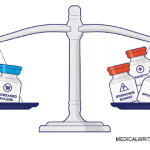A study from Denmark compared disease worsening for patients with RA, PsA or axial SpA who either stayed on etanercept or switched to its biosimilar, SB-4.4 Both groups had similar disease activity. However, 8.3% of patients in the biosimilars group discontinued the drug during follow-up due to lack of effect or adverse events. This may be due to the “nocebo effect,” when some patients mistakenly attribute symptoms to a drug due to expectation of or past experiences with side effects or misconceptions about the drug, he said.
Lower cost is the driver for switching, Dr. Kay noted. With a nod to the 18th century Enlightenment philosopher Jean-Jacques Rousseau, Dr. Kay said, “we should accept a lower-cost biosimilar so that medications are more widely available to all members of society. The availability of multiple biosimilars for the same reference product will drive prices down.”
Data from one study cannot be generalized to all indications, & in the U.S., patients do not save money with a biosimilar. —Roy Fleischmann, MD, MACR
Counter: Where’s the Discount?
Roy Fleischmann, MD, MACR, clinical professor of medicine at the University of Texas Southwestern Medical Center in Dallas, countered that data from one study cannot be generalized to all indications, and that in the U.S., patients do not save money with a biosimilar.
“Are real, considerable cost savings realized with the use of biosimilars, that accrue to the patient, who would, therefore, have greater access to biologics? If you have a biosimilar that is not cheaper for the patient, and the patient does not have greater access, you don’t need a biosimilar,” he said.
Dr. Fleischmann flashed a slide with a large, bold statement, saying, “I couldn’t fit a bigger font on the screen to emphasize this point: If it isn’t considerably cheaper to the patients and society, there is no value in using a biosimilar.”
To illustrate that the case for switching to biosimilars is relatively tepid, Dr. Fleischmann turned to a consensus statement co-authored by his debate opponent, which includes principles and recommendations for biosimilar use graded on quality and level of evidence.5 Most of the items received low grades, Dr. Fleischmann said.
“One recommendation says that biosimilars must be much cheaper than the bio-original to the patient and healthcare system—I absolutely agree. They say they are cheaper. I’m going to show you that they’re not,” said Dr. Fleischmann. “If they’re not much cheaper, then why switch?”
Dr. Fleischmann queried the director of an infusion center network partially owned by his practice to find out if the infliximab biosimilar was used and, if so, whether it saves costs.


